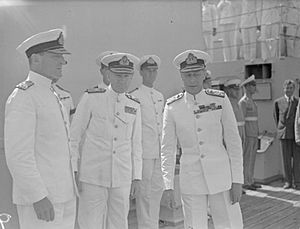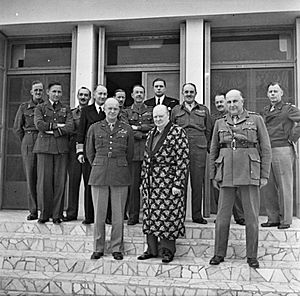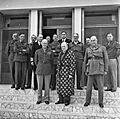John Cunningham (Royal Navy officer) facts for kids
Quick facts for kids
Sir John Cunningham
|
|
|---|---|

Portrait of Sir John Cunningham by Oswald Birley
|
|
| Born | 13 April 1885 Demerara, British Guiana |
| Died | 13 December 1962 (aged 77) London, United Kingdom |
| Allegiance | United Kingdom |
| Service/ |
Royal Navy |
| Years of service | 1900–1948 |
| Rank | Admiral of the fleet |
| Commands held | First Sea Lord Mediterranean Fleet Levant Fleet 1st Cruiser Squadron HMS Resolution HMS Adventure |
| Battles/wars | First World War Second World War |
| Awards | Knight Grand Cross of the Order of the Bath Member of the Royal Victorian Order Mentioned in Despatches Legion of Merit (United States) Order of St Olav (Norway) Legion d'honneur (France) Croix de Guerre (France) Order of George I (Greece) War Cross (Greece) |
Admiral of the Fleet Sir John Henry Dacres Cunningham (born April 13, 1885 – died December 13, 1962) was an important officer in the Royal Navy. He was a skilled navigator, which means he was an expert at guiding ships. In 1930, he became the Director of Plans at the Admiralty, which is like the main office for the Royal Navy.
During the Second World War, he was the Commander-in-Chief of the Mediterranean Fleet. This meant he was in charge of all the British naval forces in the Mediterranean Sea. He played a key role in major Allied landings, like the one at Anzio in Italy and Operation Dragoon in the south of France. After the war, in the late 1940s, he became the First Sea Lord. This was the highest-ranking officer in the Royal Navy. In this role, he helped carry out the government's plan to reduce the size of the navy by getting rid of many ships that were still useful.
Contents
John Cunningham was born in Demerara, which is now part of Guyana. His father was a lawyer. John went to Stubbington House School before joining the Royal Navy as a cadet in January 1900. A cadet is a young person training to become an officer. He started his training on the ship HMS Britannia.
In June 1901, he was sent as a midshipman to the cruiser HMS Gibraltar. A midshipman is a junior officer rank. He was promoted to sub lieutenant in 1904 and then to lieutenant in 1905. He was very good at his studies, getting top marks in all his exams.
John became a qualified navigator after studying at the Royal Navy Navigation School. He worked as an assistant navigator on the battleship HMS Illustrious and then as a senior navigator on several other ships, including the gunboat HMS Hebe and the cruiser HMS Indefatigable. He also taught navigation at the Royal Navy Navigation School. In 1913, he was promoted to lieutenant commander.
Service in the First World War
During the First World War, John Cunningham first served on HMS Berwick. In 1915, he moved to the battleship HMS Russell in the Mediterranean Sea. He was very lucky to survive when the Russell sank after hitting a mine near Malta in April 1916.
After a short break, he became the senior navigator on the battlecruiser HMS Renown. Battlecruisers were large, powerful warships. While serving in the Mediterranean, he was promoted to commander in June 1917. Later, in July 1918, he became the navigator of HMS Lion.
Between the World Wars
After the First World War, Cunningham continued to serve in the navy. He worked as an instructor again. In 1919, he became the navigator of the famous battlecruiser HMS Hood. While on the Hood, he became the main navigator for the entire battlecruiser squadron.
He later became the commander of the navigation school. In 1923, he was appointed as the master of the fleet on HMS Queen Elizabeth, which was the flagship of Admiral Sir John de Robeck. A flagship is the ship where the admiral is located.
In 1924, he was promoted to captain. He then worked at the Royal Naval College, Greenwich, which is a training college for naval officers. In 1928, he took command of the minelayer HMS Adventure. He then moved to the Admiralty in London, where he became the Deputy Director of Plans and then the Director of Plans.
In 1933, Cunningham took command of the battleship HMS Resolution. He served as the flag captain for Admiral Sir William Fisher, who was the commander-in-chief of the Mediterranean Fleet. In 1936, he was promoted to rear admiral. He also became the Assistant Chief of the Naval Staff. His duties grew when the Fleet Air Arm, which is the navy's air force, moved from the Air Ministry to the Admiralty. He was then called the Assistant Chief of the Naval Staff (Air).
In 1938, he took command of the 1st Cruiser Squadron in the Mediterranean Fleet. He flew his flag from HMS Devonshire. In 1939, he was promoted to vice admiral.
Second World War Service

When the Second World War began, Cunningham's cruiser squadron was sent to help the Home Fleet during the Norwegian campaign. In May 1940, he helped evacuate Allied troops from Namsos, Norway. The next month, he took King Haakon VII of Norway and his government ministers aboard the Devonshire to bring them safely to the United Kingdom.
Soon after they left Tromsø, the aircraft carrier HMS Glorious and two destroyers were attacked and sunk by German warships. Some sailors survived for two days on life rafts in the cold ocean before being rescued by Norwegian ships. There were many passengers on the Devonshire, including King Haakon. Cunningham's main order was to bring the King safely to England.
Cunningham was later involved in Operation Menace in September 1940. This was an attempt to capture Dakar in Senegal to use it as a base for the Free French forces, but it was not successful.

In 1941, Cunningham became the Fourth Sea Lord and Chief of Supplies and Transport. This role involved managing the navy's supplies and transport. He was honored with the title of Knight Commander of the Order of the Bath.
In June 1943, Cunningham became the Commander-in-Chief, Levant, which was a naval command in the eastern Mediterranean. He was promoted to full Admiral in August 1943. In December 1943, he became the Commander-in-Chief, Mediterranean Fleet. In this important role, he was in command of the naval forces for the Allied landing at Anzio, Italy, in 1944. He also led the naval part of Operation Dragoon, a large landing on the southern coast of France in September 1944.
For his service, Cunningham received many awards from different countries. These included the Chief Commander of the American Legion of Merit, the Grand Officier of the French Legion of Honneur, and the French Croix de Guerre. He also received awards from Greece and Norway.
First Sea Lord and Later Life
In 1946, John Cunningham was promoted to Knight Grand Cross of the Order of the Bath. In May 1946, he took over from Andrew Cunningham (who was not related to him) as the First Sea Lord. As the First Sea Lord, his main job was to carry out the government's plan to reduce the size of the Royal Navy after the war. This meant many ships that were still in good condition were taken out of service.
He was given the honor of being a Freeman of the City of London in 1946. On January 21, 1948, he was promoted to Admiral of the Fleet, the highest rank in the Royal Navy. He retired from the navy in September 1948.
After leaving the navy, Cunningham became the chairman of the Iraq Petroleum Company, an oil company. He also became a Deputy Lieutenant of Bedfordshire, which is a ceremonial role in a county in England.
Admiral Cunningham attended the coronation of Queen Elizabeth II in June 1953. He retired from the Iraq Petroleum Company in 1958 and from his role as Deputy Lieutenant in 1959. Sir John Cunningham passed away in London on December 13, 1962.
Family Life
On March 8, 1910, John Cunningham married his first cousin, Dorothy May. He had spent some of his younger years with Dorothy in Ulverston after his parents had both died at sea.
They had two sons, John and Richard. Their son John became a chief in the fire brigade. Their other son, Richard, became a lieutenant in the Royal Navy's Submarine Service. Sadly, Richard was killed during World War II in August 1941 while serving on board the submarine HMS P33.
Images for kids
-
Portrait of Sir John Cunningham by Oswald Birley
-
Cunningham (centre) with Rear Admiral John Mansfield (left) and King George VI (right).
-
A convalescent Winston Churchill meets the outgoing and incoming Supreme Commanders in the Mediterranean, Dwight D. Eisenhower, to Churchill's right, and Henry Maitland Wilson, to his left. Behind them stand (from left to right), John Whiteley, Air Marshal Arthur Tedder, Brigadier G. S. Thompson, Admiral Sir John Cunningham, unknown, Sir Harold Alexander, Captain M. L. Power, Humfrey Gale, Leslie Hollis, and Eisenhower's chief of staff, Walter Bedell Smith.




